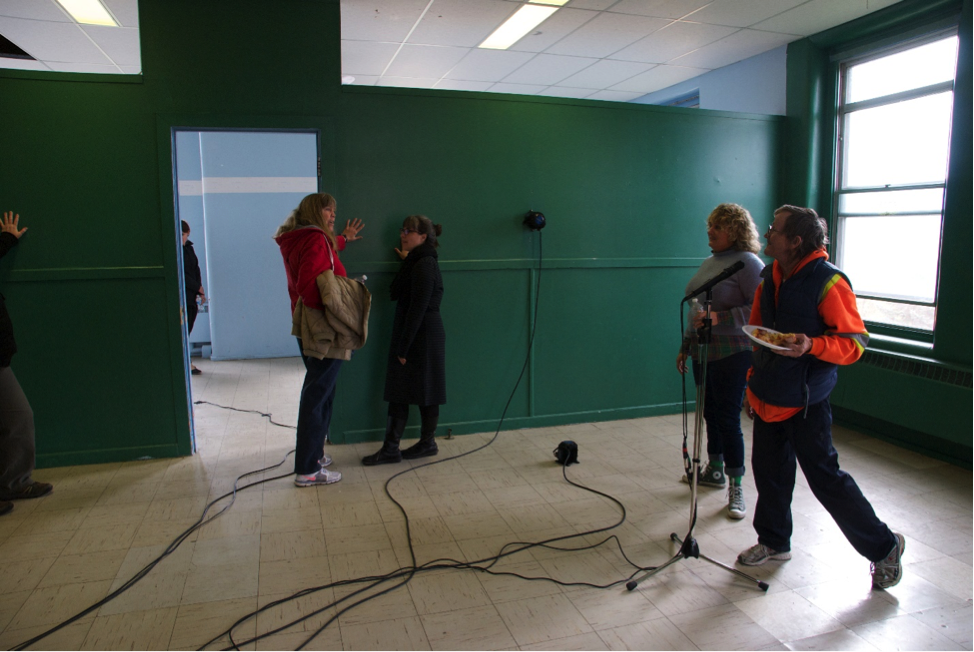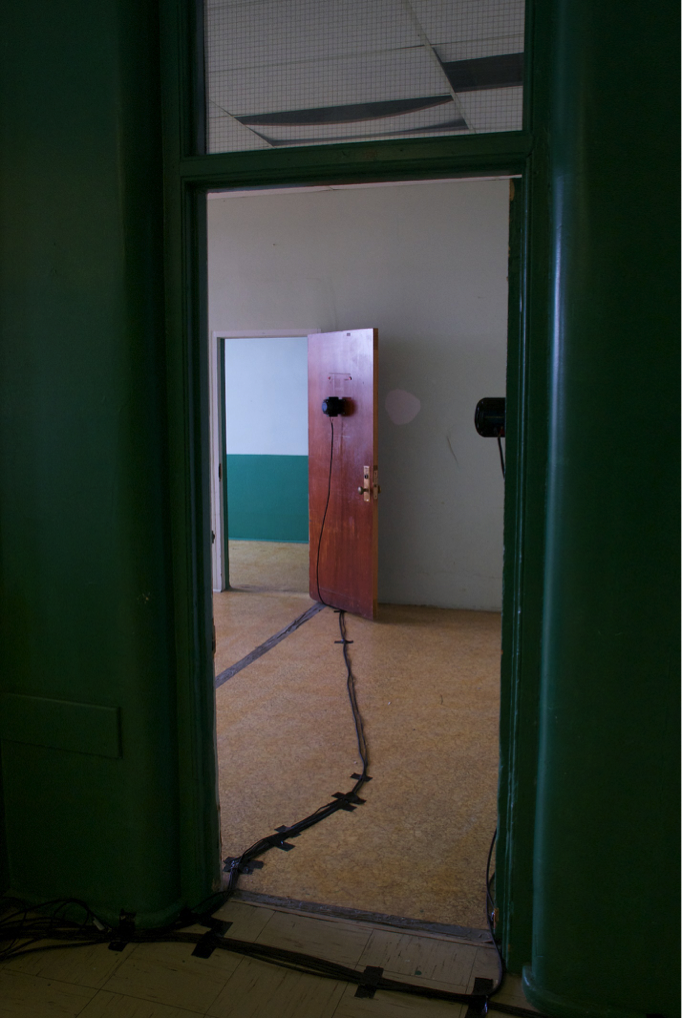Soundfull: A Wall Speaks, A Door Shakes, A Floor Trembles
Marla Hlady
University of Toronto
Christof Migone
University of Western Ontario
Abstract
What if you could use your voice to move the room you are standing in? What if your voice could crumble down walls? When the researchers of Recounting Huronia invited us to conceive of a participatory, sited sound work in the Huronia Regional Centre for the last three days of public tours October 16-18, 2014, we devised a purpose-built mobile sound-amplifying cart. It functioned as the nerve center for a solitary stereo microphone feeding an array of speakers spread over five rooms that formally constituted the first-aid nursing station of the Centre’s B-Wing. With this instrument we were able to amplify the resonances, physical and beyond, of the institution. In other words, by deploying this instrument we intended to both convey its architecture and conjure its past.
Keywords
- Soundfilling
- aural architecture
- memory
- institutionalization
Soundfull: A Wall Speaks, A Door Shakes, A Floor Trembles
Marla Hlady
University of Toronto
Christof Migone
University of Western Ontario
What if you could use your voice to move the room you are standing in? What if your voice could crumble down walls? When the researchers of Recounting Huronia invited us to conceive of a participatory, sited sound work in the Huronia Regional Centre for the last three days of public tours October 16-18, 2014, we devised a purpose-built mobile sound-amplifying cart. It functioned as the nerve center for a solitary stereo microphone feeding an array of speakers spread over five rooms that formally constituted the first-aid nursing station of the Centre's B-Wing. With this instrument we were able to amplify the resonances, physical and beyond, of the institution. In other words, by deploying this instrument we intended to both convey its architecture and conjure its past.
Importantly, Recounting Huronia’s research team comprised both academic researchers and members of the survivor community who had experienced institutionalization. The principal academic researchers of Recounting Huronia were Kate Rossiter (Wilfred Laurier University), nancy viva davis halifax (York University), and David Fancy (Brock University). Rossiter (2013) provides a summary historical account of Huronia—the institution and its consequences:
while there is still relatively little information about residents’ lived experience of Huronia, all available academic sources indicate that it was chronically underfunded and overcrowded—complaints about the standard of care ranged from neglect to outright abuse. …While Huronia was one of the biggest and best established institutions for intellectually disabled people in Canada, it was by no means the only one; across Canada people with intellectual disabilities were placed in similar institutions and now allege similar mistreatment. Persons who resided at Huronia between 1945 and 2009 initiated a class action lawsuit against the Ontario government alleging psychological, emotional, spiritual and physical harm as a result of their residence within the institution.
A central goal of the Recounting Huronia project was, according to Rossiter, “to assist adults with intellectual disabilities who have survived institutionalization tell their stories.” All the researchers, both academics and survivors, worked together in a community-based approach toward this goal of being heard through various artistic strategies. All kinds of approaches were on the table at this moment–image capturing, object retrieval, performative actions, writing words, sounding voice, and marking space. Our own contribution focused on sound and voice, architecture and space. We brought our experiences with sound to support the group’s goal of finding ways to process experience by art making. How could we shape a creative sound art activity with the intense emotional impact of this site, an institution where the people we were collaborating with had experienced unforgiveable trauma and pain? And how could we ensure the survivors were in control of their own experience, able to tell their story through what we constructed?
Our instrument, a purpose-built mobile sound amplifying cart, was rolled into the institution and positioned in the B-Wing. Unpacked, the sound equipment was integrated into the five connecting rooms, wires strung throughout those areas; site became as much a part of the instrument as the sound equipment. When conceiving of the instrument idea, we were concerned with the implication of the interface, the how of its function in relation to the researcher-participants’ ability to use it generatively towards enabling the free(ing) flow of narratives to emerge in and out of this charged place. The technology needed to be tangible and empowering, with a restricted focus to guide the participant lacking experience or to prevent a participant from encountering a creative block (Rokeby, 1995). The participants became the makers able to express themselves with a medium assembled by us; we were the creative guides (Tuer, 2005). The interactive structure of this instrument used the microphone to tell, or yell, or sound out stories, with us at the mixing board negotiating volume levels in the space and on the recording devices. The vital element of the entire setup was that it was devised so that the live and direct acts of testifying were transformed into vibrations that made the walls speak, the doors shake and the floor tremble.
How is this sounding made possible? It begins with a microphone that is simply there, there to capture, to amplify, to testify. It is inanimate, but active. It is an earwitness, it listens to the room. Not only that, the speakers in its proximity playback what the microphone hears, and in turn, the microphone hears that too. The resulting circularity intrinsic to a feedback loop raises the volume by exponential accretion. Rapidly, control is no longer possible, the sharp pure tones pierce the ears, and almost-audible cringes appear as the din causes those within earshot to cower. There is a certain violence to this moment; we are misusing the equipment, pushing its limits. The feedback triggers an automatic defense mechanism that is concerned for the health of the eardrum. Our tympana have heard enough. But this noisy scene also offers an entry into the undertow of a site, its invisible parameters, its affective signature. The artistice mapping of a space through sound does not yield an accurate set of measurements. That is not the purpose of this sonic map, rather it is to investigate how bodies navigate spaces, especially crisis ones. Blesser and Salter (2007), in Spaces Speak, Are You Listening?, describe how we encounter sound and architecture:
Auditory spatial awareness is more than just the ability to detect that space has changed sounds; it includes as well the emotional and behavioral experience of space. For example, detecting reverberation is different than responding to it. Listeners react both to sound sources and to spatial acoustics because each is an aural stimulus with social, cultural, and personal meanings (p. 11).
The rooms, floors, walls, windows, doors, ceilings of B-Wing have amassed collective memories. They propagate through a circuitry that our instrument was seeking to acknowledge and amplify. The sounding material generated by one room blurs into that of the next. Sounds waves pass through a floor or a wall or a door on their way to your body: a sounding surface, capable of moving your body at the same time as it is sounded. Walls do not impede sound, they both absorb and reflect, they remember and speak back.
Further to the voice-activated vibratory soundscapes we also focused on each room listening to itself, bare, on its own—pure room tone. That is to say, we wanted to investigate the institutional architecture's sonic properties when it was made part of an instrument intentionally tuned to produce piercing tones and excessive vibration. By taking this route we wanted to align ourselves sympathetically with the provocative questions posed by Meacher (2003):
How can we come to understand acts of radical defacement, destruction, and violence against the modern image, sculpture or edifice? [H]ow do we make sense of the spontaneous and creative gestures that are born, phoenix-like, out of the displaced energy of sites of desecration and loss? (p. 28).
Sound’s ephemeral materiality is typically reproduced through speakers made of cones and magnetic coils that disseminate the sound they produce through air. Sound generated through surface resonating technology, where the magnetic coil activates a surface instead of air, means sound adopts a more haptic and tactile form. The vibrations produced by the latter kind of speakers generate a visceral affect. Surface resonators are less defined in terms of relaying conventional content, but they can unleash and unravel a space in a manner that is paradoxically both super-concrete and ultra-abstract. They tap into what lies beyond the readily apparent and the immediately discernible. The accompanying images serve as documents—they provide clues but are ultimately unable to fully reveal the time-based sonic signature our instrument was devised to draw out. Given the context, our instrument was tailored to enact a soundfilling—a full spectrum of sonic phenomena. The accompanying sounds sketch a portrait of the institution through our interpretation of its physical and psychological dimensions.
In our intervention we used speakers of various kinds, shapes, and sizes as an ensemble tailored to reproduce a wide range of frequencies; but bass predominated: rumbling, crumbling, and sonically advocating, predictively resonating, sympathetically vibrating with and to the call by some survivors to tear the place down. And we did, at least sonically.
Sounds
Soundfull (Huronia) - long version (12:36)
Soundfull (Huronia) - short version (8:02)
Images





Project Credits
- Concept: Marla Hlady and Christof Migone
- Image credits: Marla Hlady
- Site recordings: Marla Hlady and Christof Migone
- Post-production: Christof Migone
- Assistant on site: Lauren Cullen
References
- Blesser, B., & Salter, L (2007). Spaces Speak, are you Listening? Experiencing Aural Architecture. Cambridge: The MIT Press.
- Meacher, C. (2003). Impish acts of sabotage. In K. Ehrlich, & B. LaBelle (Eds.), Surface
- Tension: Problematics of Site (pp. 25-38). Los Angeles: Errant Bodies Press.
- Rokeby, D. (1995). Transforming mirrors: Subjectivity and control in interactive media. In S. Penny (Ed.), Critical Issues in Electronic Media (p. 144). Albany: State University of New York Press.
- Rossiter, K. (2013). Renovating Huronia. Huronia Ethics Application. Brantford: Wilfred Laurier.
- Tuer, D. (2005). Embodying the virtual, hybrid subjectivity and new technologies. Mining the Media Archive: Essays on Art, Technology, and Cultural Resistance. Toronto: YYZ Books.